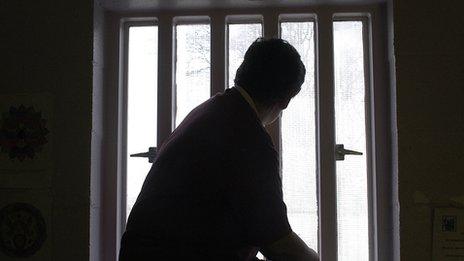Self-harm 'four times more likely' in female prisoners
- Published

Female prisoners have high rates of self-harming
Self-harm is a serious issue for women in prison, who make up only 5% of the prison population but account for half of all self-harm incidents, say Oxford University researchers.
According to a study in The Lancet, external, nearly a quarter of female prisoners cut, scratch or poison themselves.
Self-harm was also found to be a strong risk factor for suicide in prison, particularly among men.
Experts say more should be done to reduce self-harm rates in prisons.
The Oxford research team looked at self-harm incidents in all prisons in England and Wales between 2004 and 2009.
It found that 5% to 6% of male prisoners and 20% to 24% of female prisoners deliberately harmed themselves every year, resulting in 20,000 to 25,000 incidents per year.
This compared with a 0.6% rate among the UK's general population.
Suicide risk
Repeated self-harming was common, the study said, and a small group of 102 women inmates self-harmed more than 100 times a year.
Cutting and scratching were the most frequent methods of self-harming in men and women, followed by poisoning and overdosing.
The study also examined those at greatest risk of self-harm. In female prisoners, being younger than 20 years old, white, in a mixed local prison, or serving a life sentence were major factors.
In male prisoners, those at risk tended to be young, white, in a high-security prison and with a life sentence or unsentenced.
Prisoners who self-harmed were found to be at "substantially greater" risk of suicide than other inmates, particularly among men.
Older male prisoners (aged 30 to 49) with a history of serious self-harm were most at risk.
Dr Seena Fazel, joint study author from the department of psychiatry at the University of Oxford, said all prisoners who are self-harming should be regarded as a risk.
"Now we know the extent to which the risk of subsequent suicide in prisoners who self-harm is greater than the general population, suicide prevention initiatives should be changed to include a focus on prisoners who are self-harming, especially repeatedly."
'Joined up care'
Writing in a Comment article in The Lancet, external, Dr Andrew Forrester from King's College London, and Dr Karen Slade from Nottingham Trent University call for more research to address how the self-harm rate in prisons in England and Wales can be reduced.
"The available evidence indicates a key role for multi-agency collaboration, in which suicide is everyone's concern, rather than being the sole preserve of healthcare staff.
"We need to invest in the wide inclusion of all people who, on the ground, can listen to prisoners who are experiencing distress, mobilise concern, and help to deliver joined up care."
Andy Bell, deputy chief executive at the Centre for Mental Health, external, said it was well known that women in prison were more likely to have depression, anxiety and borderline personality disorder which, in turn, can make them extremely vulnerable.
He added it was important to be aware of those at risk at an early stage.
"Women should have access to mental health support and advice at every police station. It should start when they are arrested, particularly if there are signs of self-harming or poor mental health. We have to intervene early to stop the journey."
- Published1 March 2013
- Published17 November 2011